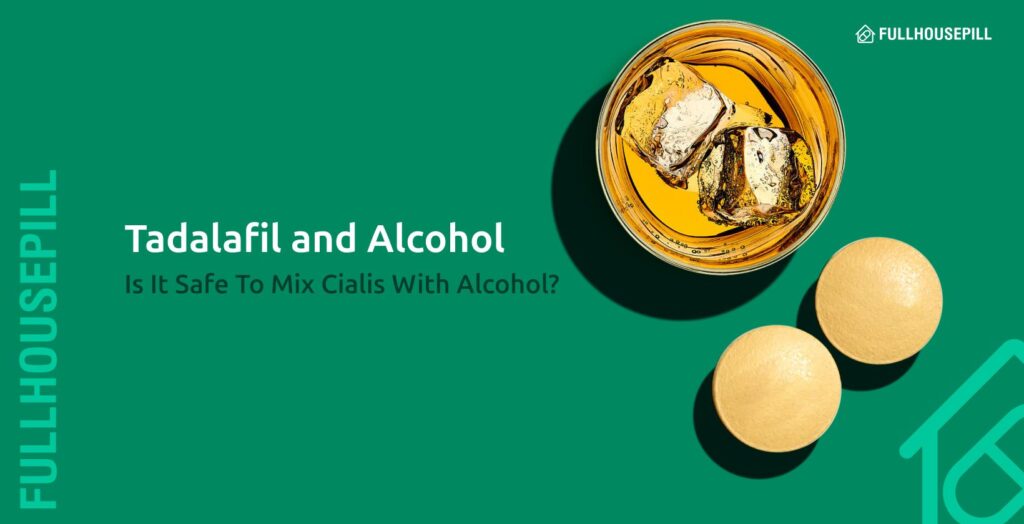Tadalafil, the active ingredient in Cialis, is a widely prescribed drug for erectile dysfunction, but its interaction with alcohol raises safety concerns. Both tadalafil and alcohol act as vasodilators, lowering blood pressure through different mechanisms. According to the Cardiovascular Effects of Tadalafil study, tadalafil decreases systolic blood pressure by 3–5 mmHg in healthy adults through PDE5 inhibition and smooth muscle relaxation. Alcohol, on the other hand, induces vasodilation by stimulating nitric oxide pathways, as confirmed by the Moderate Ethanol Ingestion and Cardiovascular Protection study.
When combined, these mechanisms can compound, creating orthostatic hypotension and dizziness, as reported in the European Medicines Agency Tadalafil Assessment. Clinical safety data also show that the risk of adverse effects such as fainting, flushing, and headache increases in patients who mix alcohol with PDE5 inhibitors, with the Influence of Alcohol on Phosphodiesterase 5 Inhibitors Use study finding that 69.6% of alcohol users reported flushing compared to 12.4% of non-users.
In this article, we will cover what Tadalafil is, how it works, alcohol’s effect on sexual function, and what happens when you mix Tadalafil with Alcohol.
What is Tadalafil (Cialis)?
Tadalafil or Cialis (Brand) is a first-line oral prescription medication approved by the FDA for the treatment of Erectile Dysfunction (ED). It belongs to a special drug class of PDE5 (Phosphodiesterase 5 enzyme) inhibitors, which help men achieve and maintain a firm erection for sexual intercourse. A 2005 double-blind, placebo-controlled study published in The Journal of Sexual Medicine, analysing 2,102 men with a broad spectrum of ED etiology and comorbidities, reported that the percentage of positive responses regarding improvement in erectile function increased from 72% to 91% for patients on tadalafil 20 mg and from 52% to 94% for tadalafil 10 mg.
Tadalafil, without sexual arousal, cannot directly cause an erection. It begins to function and show effect in response to sexual stimulation. As a PDE5 inhibitor, Tadalafil works by inhibiting the breakdown of cyclic GMP (Guanosine 3′,5′-cyclic monophosphate), a messenger molecule responsible for dilating the penile blood vessels and enhancing blood flow to the penis. When Tadalafil is effective in your system, cGMP molecules keep accumulating in the penis, increasing blood flow to the penis for a stronger erection.
Among all PDE5 inhibitors available in the market today, Tadalafil offers the longest duration of effect and can last up to 36 hours after a single dose. It is best suited for men who want longer effectiveness, highly suitable if you are looking for spontaneous sex more than once a day. Due to its long half-life (17.5 hours) and high bioavailability, Tadalafil can remain active in your system for a long time.
How Alcohol Affects the Body and Sexual Function?
Alcohol negatively affects sexual function by disrupting the nervous system, damaging blood vessels, and altering hormonal balance. It produces both short-term impairments and long-term dysfunctions that reduce libido and erection quality.
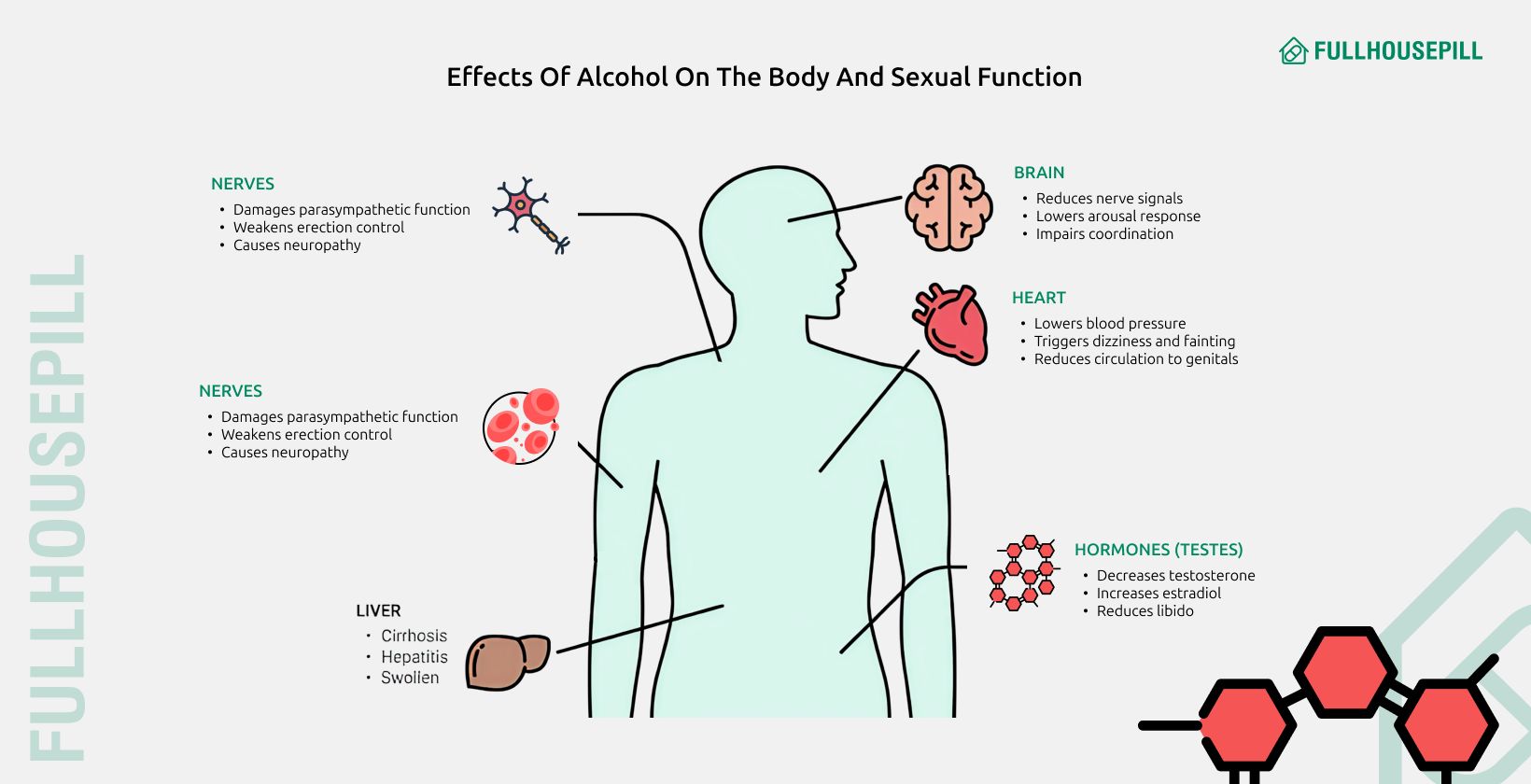
Alcohol acts as a central nervous system depressant, reducing nerve signal transmission between the brain and sexual organs. According to The Effect of Alcohol Administration on the Corpus Cavernosum study, alcohol decreases penile sensitivity and impairs erectile response. The Alcohol-induced Autonomic Dysfunction: A Systematic Review found that 16–73% of chronic alcohol abusers experience autonomic dysfunction, with erectile dysfunction being the most common outcome.
Alcohol inhibits parasympathetic nervous system activity, which is necessary for smooth muscle relaxation in the penis. A study on Erectile Dysfunction as a Sentinel Symptom reported that 26% of heavy drinkers showed abnormal autonomic function, while 74% developed peripheral neuropathy that impaired erectile capacity.
Alcohol also affects blood vessels and circulation. Acute consumption may cause vasodilation through β-receptor activation and increased cAMP levels, improving corpus cavernosum relaxation. However, the Meta-Analysis of Erectile Dysfunction and Alcohol Consumption showed a J-shaped association: moderate intake had slight protective effects, but chronic heavy use caused vascular damage and significantly increased ED risk.
Chronic alcohol consumption further causes endothelial dysfunction by suppressing endothelial nitric oxide synthase (eNOS), which reduces nitric oxide needed for penile blood vessel dilation. This impairment limits blood flow to erectile tissue, preventing firm and sustained erections.
Short-term alcohol effects on sexual performance are dose dependent. The Alcohol and Erectile Response: The Effects of High Dosage study showed that blood alcohol concentrations of 0.10% reduced peak penile circumference change while sparing overall erectile response at moderate levels. Low doses may increase subjective arousal by lowering inhibition, but levels above 0.08% impair erection latency and rigidity. These effects often manifest as decreased penile sensitivity, delayed orgasm, and reduced coordination during intercourse.
Long-term alcohol use disrupts endocrine balance. The Relationship between Alcohol Consumption and Testosterone study demonstrated that men consuming more than 8 drinks per week had a 4.37 times higher risk of testosterone deficiency. A meta-analysis on alcohol and the gonadal axis confirmed reductions in total testosterone, free testosterone, and sex hormone-binding globulin, alongside increased estradiol levels, due to suppression of the hypothalamic-pituitary-testicular axis.
Alcohol dependence strongly correlates with chronic sexual dysfunction. The Sexual Dysfunctions in Alcohol-Dependent Men study reported that 75.7% of affected individuals experienced problems such as erectile dysfunction, premature ejaculation, and reduced libido. Severity was directly related to the duration and intensity of alcohol consumption, leading to reduced marital satisfaction and impaired quality of life.
What Happens When You Mix Tadalafil and Alcohol?
Mixing tadalafil with alcohol amplifies vasodilation, creating cardiovascular instability and increasing the risk of orthostatic hypotension. Both agents expand blood vessels through distinct mechanisms that, when combined, compound their physiological effects.
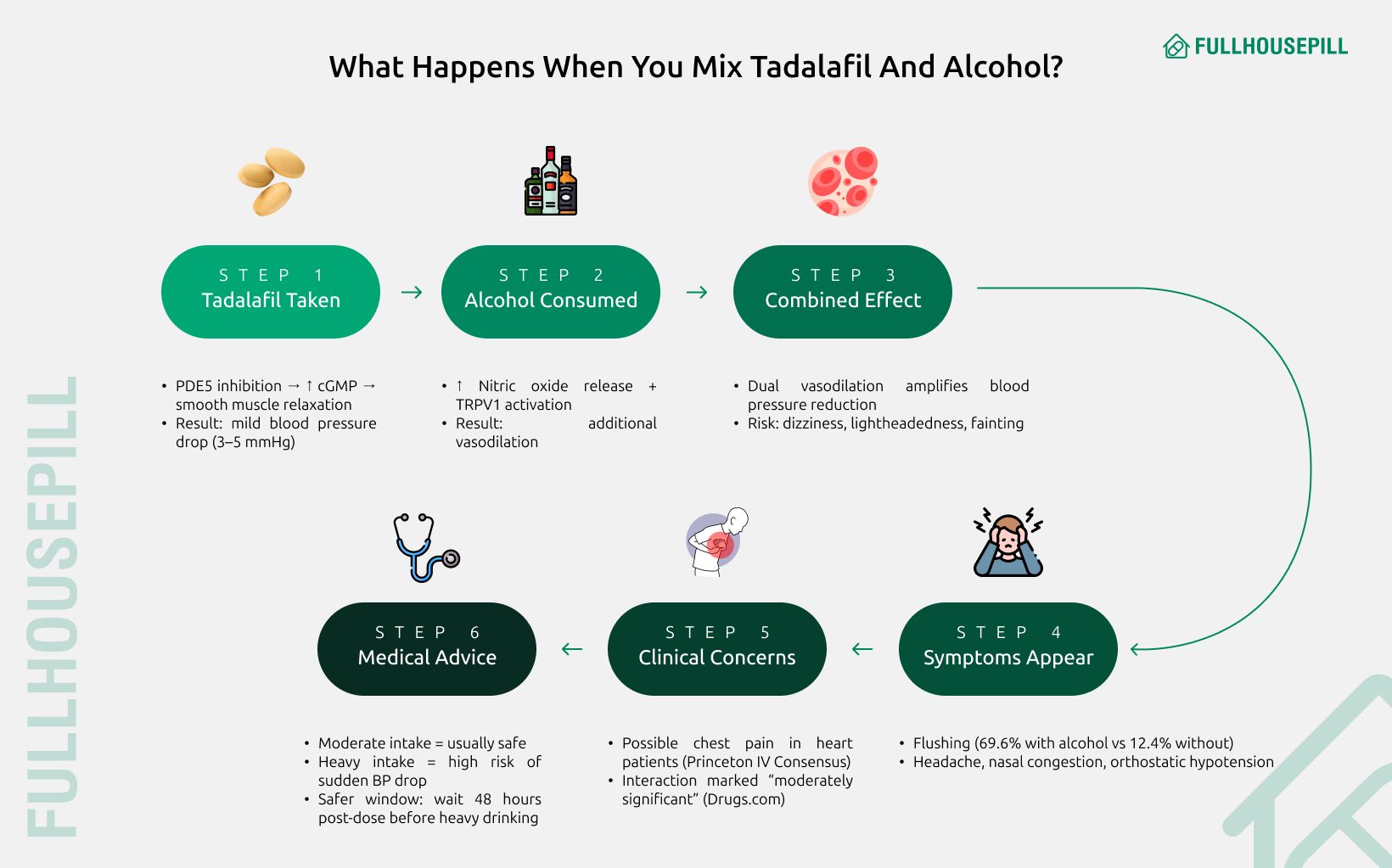
Tadalafil functions as a selective PDE5 inhibitor that prevents cGMP degradation, promoting smooth muscle relaxation and systemic vasodilation. According to the Cardiovascular Effects of Tadalafil study, this action lowers standing systolic blood pressure by 3–5 mmHg in healthy adults. Alcohol also produces vasodilation but through nitric oxide–mediated pathways. The Moderate Ethanol Ingestion and Cardiovascular Protection study showed that alcohol increases nitric oxide synthase activity and activates TRPV1 channels, releasing CGRP, which further dilates vessels. Supporting this, the Physio-pathological Effects of Alcohol on the Cardiovascular System research confirmed that low alcohol concentrations dilate blood vessels through calcium and endothelium-derived nitric oxide mechanisms.
These dual pathways generate stronger blood pressure reductions when both agents are used together. The European Medicines Agency Tadalafil Assessment documented that although tadalafil 20 mg did not significantly increase mean blood pressure drops with moderate alcohol intake (0.7 g/kg), subjects frequently experienced postural dizziness and orthostatic hypotension. The Influence of Alcohol on Phosphodiesterase 5 Inhibitors Use study further revealed that 69.6% of patients combining alcohol with PDE5 inhibitors developed flushing, compared to only 12.4% without alcohol. Symptoms like headache and nasal congestion also appeared more rapidly and severely in those mixing the two.
The safety data underscore the risk of sudden blood pressure shifts. The Analysis of Integrated Clinical Safety Data of Tadalafil involving 4,000 participants showed cases of orthostatic hypotension presenting as dizziness, fainting, and rapid heart rate. The Pharmacokinetics and Safety Profiles of Tadalafil/Tamsulosin study confirmed that orthostatic hypotension incidence rose to 40.0% in fasted conditions and 17.1% in fed conditions when vasodilatory drugs were combined, although no subject’s systolic blood pressure fell below 90 mmHg. This indicates a clinically relevant but manageable safety risk.
Guideline consensus also highlights potential cardiovascular complications. The Princeton IV Consensus described how dual vasodilation may cause a coronary steal phenomenon, diverting blood from coronary vessels and provoking chest pain in predisposed patients. The StatPearls Tadalafil Monograph emphasizes that excessive alcohol intake markedly elevates the risk of orthostatic hypotension when combined with tadalafil, necessitating cardiovascular caution. The Drugs.com Interaction Database classifies this interaction as “moderately clinically significant,” recommending limited alcohol consumption.
Clinical advice therefore stresses moderation. Moderate intake, defined as up to two drinks daily, is generally safe for healthy adults. However, excessive drinking with tadalafil creates dangerous blood pressure drops and increases the chance of dizziness or fainting. Given tadalafil’s half-life of 17.5 hours, at least 48 hours should pass after dosing before consuming large amounts of alcohol to reduce risks.
What are the side effects of mixing Tadalafil with Alcohol?
As is often the case, drinking in moderation is not usually a problem; having 1 or 2 drinks whilst taking Tadalafil is okay for some people. However, you must be vigilant about your alcohol intake while on Tadalafil, as excess alcohol consumption can lead to many side effects, some of which could be dangerous.
Some potential side effects, some of which can last up to 24 hours are mentioned below.
| Side Effect | Effect of Tadalafil and Alcohol |
| Headaches | Both Tadalafil and Alcohol can cause headaches due to dehydration; combining the two can make your headaches more pronounced. |
| Dizziness | Tadalafil and alcohol both dilate your blood vessels. Combined effect could impact the blood flow, leading to dizziness or fainting. |
| Facial or neck flushing | Blood vessels close to the skin and neck dilate, owing to the changes in blood pressure and flow. |
| Changes in vision | Tadalafil and alcohol combination can shift fluids in your eyes, causing temporary vision changes. |
| Digestive issues | While Tadalafil doesn’t generally cause digestive issues, alcohol can irritate your stomach lining, resulting in nausea and digestive issues. |
These side effects are usually temporary and not dangerous. However, some effects of combining Tadalafil with heavy alcohol use can be severe and require immediate medical attention.
| Side Effect | Effect of Tadalafil and Alcohol |
| Chest pain | The heart is deprived of oxygen-rich blood due to drops in blood pressure. |
| Shortness of breath | Fluid buildup in your lungs can make breathing difficult. |
| Orthostatic Hypotension | A dangerous side effect due to the combined vasodilatation of Tadalafil and Alcohol. |
| Irregular heartbeat | Impaired nerve signals disrupt the heart rhythm from excessive Alcohol use and Tadalafil combination. |
These side effects are dangerous for your long-term health, and you must continuously monitor yourself or drink conservatively while on Tadalafil medication.
One of the critical things to remember is that alcohol also impairs your judgment and memory. It impacts how you make decisions based on what you remember. Under the influence, you can easily take more than the recommended dose of Tadalafil, which, when combined with alcohol, can lead to dangerous drug interactions.
Who should avoid mixing Tadalafil and Alcohol?
Patients with cardiovascular, hepatic, renal, and blood pressure complications should avoid mixing tadalafil with alcohol, as the combination increases vasodilatory risks and compromises drug clearance.
- Heart conditions: Patients with recent myocardial infarction, unstable angina, or arrhythmias face amplified risks. According to the Cardiovascular Effects of Tadalafil study, severe cardiac patients experienced greater hypotension when tadalafil was combined with vasodilators. The Tadalafil Use in Cardiovascular Disease research confirmed that alcohol creates unpredictable effects in such patients, and the StatPearls Tadalafil Monograph identified severe heart failure as a high-risk group.
- Liver disease: Severe hepatic impairment makes tadalafil-alcohol use unsafe. The Tadalafil, a Phosphodiesterase-5 Inhibitor study in chronic liver disease found that Child-Pugh Class C patients should avoid tadalafil entirely. The Pulmonary Hypertension Association Guidelines confirmed severe liver disease as an absolute contraindication, while the Effects of Gender, Age, Diabetes Mellitus and Renal and Hepatic Impairment research showed that only severe cases lead to unpredictable metabolism when combined with alcohol.
- Kidney problems: Severe renal dysfunction increases tadalafil exposure and prolongs drug half-life. The Effects of Renal Impairment on Tadalafil Pharmacokinetics study revealed a twofold rise in drug exposure in patients with creatinine clearance below 30 ml/min, and end-stage renal failure tripled metabolite exposure. The Pulmonary Hypertension Association advised avoiding tadalafil in severe kidney disease and dialysis patients due to drug accumulation risks.
- Blood pressure issues and elderly patients: Hypotension and hypertension patients are more vulnerable to blood pressure drops when mixing tadalafil with alcohol. A Randomized Double-Blind Placebo-Controlled Cross-Over Trial in spinal cord injury patients showed that tadalafil increased compensatory heart rate to stabilize pressure. The Pharmacokinetics and Safety Profiles study reported a 40.0% incidence of orthostatic hypotension when tadalafil was combined with vasodilators. The Analysis of Integrated Clinical Safety Data highlighted compounded risks in elderly patients already managing multiple blood pressure medications.
- Medication interactions: Nitrate therapy is strictly contraindicated. The Tadalafil and Nitrates Guidance stated this mix can cause fatal hypotension, and the 9 Tadalafil Interactions research advised avoiding nitrates for at least 48 hours after tadalafil use. Alpha-blockers also create risks, with the Canadian Prescribing Information noting symptomatic hypotension when combined with tadalafil. The Princeton IV Consensus Guidelines recommended initiating PDE5 inhibitors only after achieving stable alpha-blocker therapy, starting at the lowest effective dose.
Some groups of people who are at increased risk from the combination of Tadalafil and Alcohol are:
| Group | Why are they at risk? |
| People with heart conditions (Hypertension or Hypotension) | The low blood pressure from the combination of Tadalafil and Alcohol can trigger arrhythmias or worsen heart failure. |
| Those with low blood pressure or taking hypertensives like nitrates, other vasodilators, and alpha blockers | Tadalafil + Alcohol can cause dangerously low BP, leading to fainting or falls. Combining the medications can cause adverse drug interactions. |
| Older adults (65+ years) | Age-related changes in circulation and metabolism can heighten sensitivity to both Tadalafil and Alcohol, possibly increasing the severity of side effects, for eg, orthostatic hypotension. |
| Individuals with liver conditions | Both Tadalafil & Alcohol are metabolised by the liver, increasing the risk of severe hepatic impairment. |
| People with kidney problems | Severe renal dysfunction can affect drug clearance and can initiate unwanted drug interactions. |
How long after you drink can you take Cialis?
There is no official time to take Cialis after moderate drinking (1-2 drinks). If you had one or two drinks before, it should be okay to take Cialis (daily) at your usual time. But you have to be aware of your alcohol intake and cut yourself off after 2 drinks if you are planning to take Cialis later. Since Cialis is active in your system for 36 hours, consuming excess alcohol during that active window can still lead to negative side effects.
That is because Cialis and excessive alcohol can result in dangerous drug interactions. In one study, 6 ounces of 80-proof vodka ingested by male participants in combination with Tadalafil, reported postural dizziness and orthostatic hypotension in some participants. Significant decreases in blood pressure were also reported in more males compared to alcohol alone. If you start feeling lightheaded, dizzy, or unwell after having alcohol and Tadalafil, stop drinking immediately and seek medical attention.
Can you drink alcohol after taking Tadalafil?
It is best to limit your alcohol intake to 1-2 drinks if you have taken Tadalafil at some point during the day. Moderate alcohol intake is considered safe when Tadalafil is taken as prescribed. Excessive alcohol may reduce the effect of Tadalafil, delaying its effects and making it more difficult to achieve an erection.
One of the unique elements that sets Tadalafil apart from other PDE5 inhibitors is its long duration of effect. Tadalafil can remain active in your system for up to 36 hours after you take it. It means that alcohol intake within the next 36 hours is to be handled with caution.
If you are a heavy drinker, or it happens to be one of those days when you know you will end up drinking a lot, it’s best if you don’t take Tadalafil on the same day. Alternatively, you may consider choosing another ED pill with a shorter duration of effect, like Vardenafil (Levitra) or Sildenafil (Viagra).
How long after taking Tadalafil can you drink Alcohol?
Most doctors advise waiting at least 2-3 hours after taking Tadalafil before having a small amount of alcohol, like a glass of wine or a beer. It is because the timing between taking Tadalafil and alcohol consumption is an important consideration to minimise risks. Tadalafil (active ingredient of Cialis) has the longest half-life (17.5 hours) and can stay active in your system for up to 36 hours. That’s why it is called the “weekend pill”, take one pill on Friday and you are good to go till Sunday.
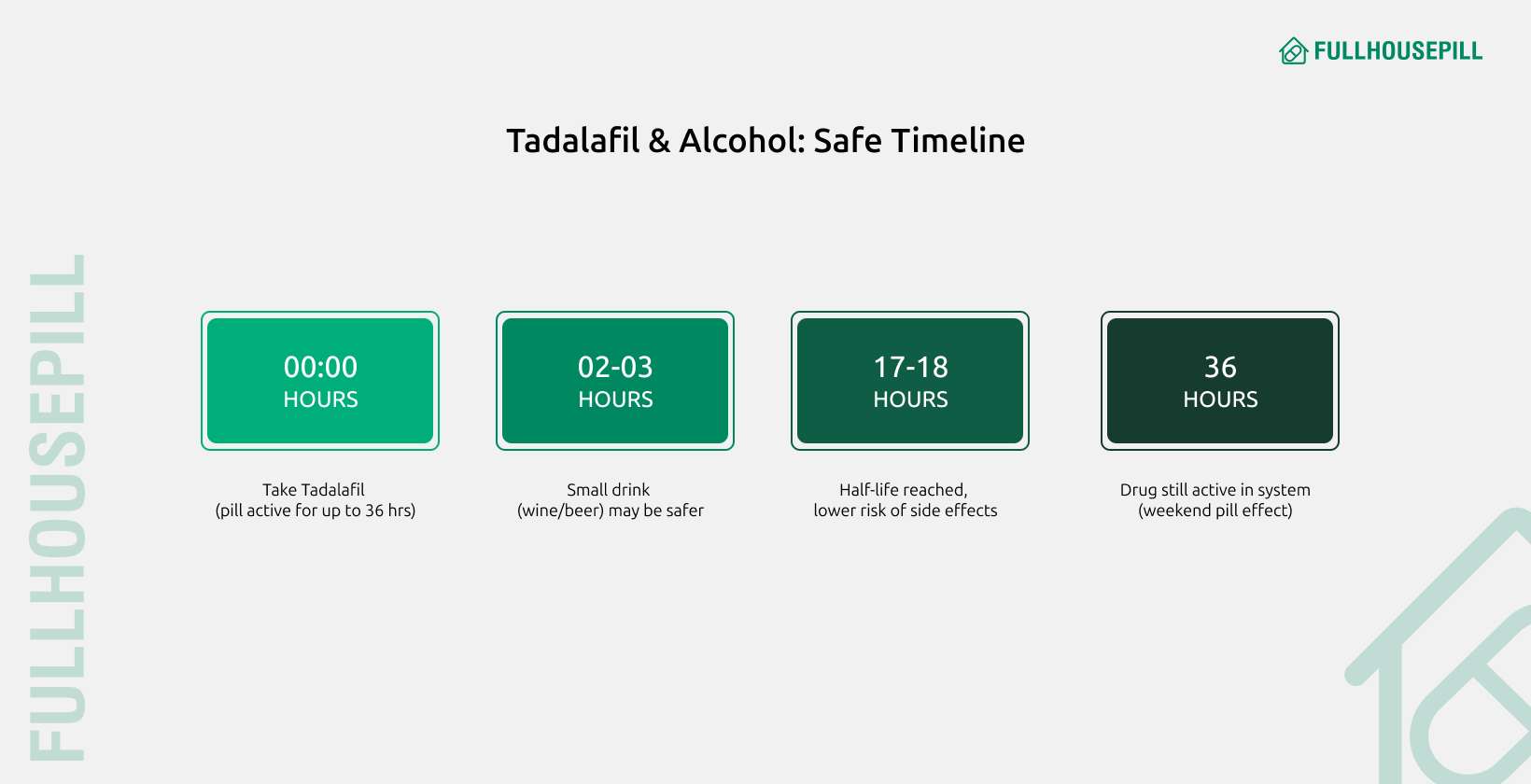
It is best to wait until after the medication has reached its half-life (17-18 hours after taking Tadalafil) to have an alcoholic drink, as the risk of adverse drug reactions decreases over time. Suppose you are planning to drink later in the day. In that case, it’s best to avoid taking Tadalafil the same day and ask your healthcare provider about shorter-acting ED treatments like Sildenafil (Viagra) or Vardenafil (Levitra).
Is it safe to drink alcohol with Cialis (Tadalafil)?
No, it is not safe to drink alcohol while taking Cialis (Tadalafil), especially if you are drinking in excess. This is because both Alcohol and Tadalafil are vasodilators, which can act in conjunction with each other, leading to a dangerous drop in blood pressure (severe hypotension) and orthostatic hypotension in older adults (above 65 years of age). The combined vasodilatory effect can result in dizziness, lightheadedness, fainting spells, falls, and irregular heart palpitations. Increased alcohol intake may also dilute the effects of Tadalafil, reducing its efficacy, resulting in increased difficulty in achieving or maintaining a strong erection.
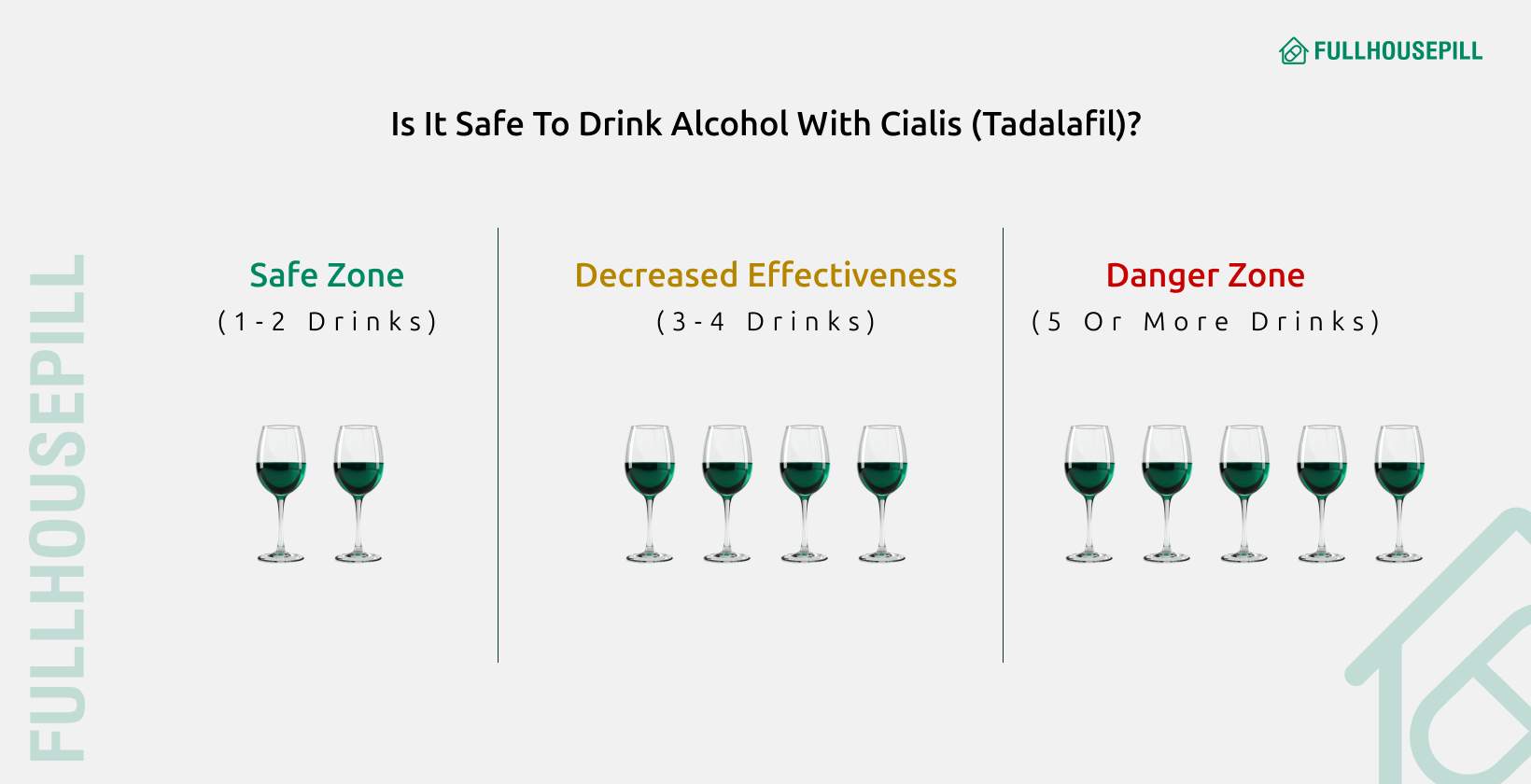
Limiting yourself to 1-2 alcoholic drinks or avoiding alcohol altogether while on Tadalafil is the safest option with minimal risks. Here are a few guidelines on making some informed choices:
- Stay hydrated: Alcohol is a diuretic, causing dehydration of the body, which can interfere with Tadalafil’s pharmacodynamics and make it less effective.
- Limit your alcohol intake: Stick to 1-2 drinks to avoid any risk of dangerous drug interactions.
- Plan social outings carefully so that you can make comfortable choices about alcohol without feeling pressured in that environment.
- Consider the timing of Tadalafil intake and alcohol consumption carefully, allowing sufficient time between the two activities to reduce risks.
- Monitor your body’s responses. If you start feeling symptoms of adverse drug interactions such as low blood pressure, lightheaded, or dizziness, stop drinking immediately and seek help.
- Know that individual responses to alcohol and prescription medication vary based on genetics, age, lifestyle, and overall health.
How much alcohol is safe with Tadalafil?
Moderation is key. Having 1-2 alcoholic drinks, which falls under the caveat of “Moderate Drinking,” should be safe to be taken with Tadalafil. For that, we must know what moderate drinking is and what counts as one drink of alcohol. The Centers for Disease Control and Prevention defines moderate drinking as,
- One serving of alcohol per day, for women and,
- Two servings of alcohol per day, for men.
One serving of alcohol or one drink can be interpreted as:
- 12 ounces or 355 ml of beer (ABV 5%)
- 5 ounces or 148 ml of wine
- 8 ounces or 237 ml of liquor
- 1.5 ounces or 44 ml of 80-proof liquor (includes brandy, tequila, vodka, whiskey, gin, and rum)
[ABV: alcohol by volume]
Heavy drinking or having more than 3 alcoholic drinks may increase the risk of dangerous drug interactions, which should be promptly avoided when taking Tadalafil.
Can I drink wine, beer, or other alcohol with Cialis?
When you are taking Cialis, it is best to drink in moderation. Moderate drinking constitutes limiting yourself to 1-2 alcoholic drinks or servings. The safest serving of drink permissible while taking Cialis is either:
- Beer: 12 ounces of regular beer (5% ABV) or,
- Wine: 5 ounces of wine or,
- Distilled spirit: 1.5 ounces of 80-proof liquor.
Which ED Drug Works Best With Alcohol?
Erectile dysfunction drugs vary in how they interact with alcohol. Clinical studies show that sildenafil and vardenafil are generally the safest choices when taken with moderate drinking. These drugs rarely produce severe interactions when alcohol intake remains low. Tadalafil requires more caution because its effects last up to 36 hours, which extends the window for side effects. Avanafil allows moderate drinking but becomes risky with excess. The effectiveness of any ED medication decreases when alcohol intake is high. This makes the combination of ED drug with alcohol safest only when consumption is minimal and controlled.
Does Alcohol Affect How Long Does Tadalafil Last?
Tadalafil usually provides effects for up to 36 hours. Alcohol does not reduce this duration directly but can alter how the body processes the drug. Heavy drinking slows metabolism and may delay the onset of action. In some cases, it cancels the benefits by causing alcohol-induced erectile dysfunction. Moderate drinking, such as one or two drinks, rarely interferes with performance. However, the long action period of tadalafil increases the chance of side effects when alcohol is added. The answer to how long tadalafil last stays the same, but alcohol use can change how well it works within that timeframe.
Can you drink alcohol with Sildenafil?
In general, it is best to limit alcohol consumption or avoid it altogether when taking Sildenafil. Sildenafil (Viagra) is also a PDE5 inhibitor. It also has the same vasodilatory effects as alcohol, and in some cases, alcohol can prevent Sildenafil from working and taking effect. Due to the combination of excessive alcohol, it may be more difficult or take you longer to get an erection, even if you take Sildenafil.
In one case, a 41-year-old man died from cerebrovascular hemorrhage after consuming two 50 mg Sildenafil tablets. Other cases have also reported subarachnoid and intracerebral hemorrhage in a 42-year-old man following alcohol consumption and Sildenafil use. Though these events are rare, the combination of alcohol with Sildenafil can increase the risk of spontaneous hemorrhage without any precedent, particularly with higher-dose Sildenafil and individual susceptibility factors.
